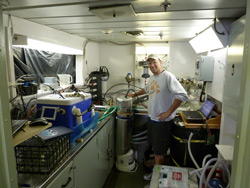Professor Mike DeGrandpre, University of MontanaAugust 16, 2012Where's the ice? My research project depends upon finding an ice pack that will survive for at least 1-2 years. Our CO2 sensors will be deployed on the Woods Hole Ice Tethered Profilers, or ITPs, which are autonomous drifting measurement systems (see www.whoi.edu/itp/). The ITPs have a profiling instrument that climbs up and down a cable suspended in the water column below the ice, measuring temperature, salinity, oxygen and other parameters. Our sensors will be fixed on the ITP directly below the ice to record CO2 levels in the central Beaufort Sea. Very little is known about the carbon cycle in the Arctic Ocean, especially during the dark, frigid, winter months when ship travel is limited. The sensors will provide baseline data for understanding to what extent CO2 levels change with warming in the Arctic. As the ice thins or melts away completely, light penetration increases, and waves and winds can mix the exposed water and these have complex consequences for the carbon cycle and the potential for release of CO2 to the atmosphere (a positive feedback for global warming) is unknown. Right now we're spending time in the southern Beaufort Sea, where ice has become, with Arctic warming, non-existent this time of the year. But next week we should be in more 'permanent' ice where we can deploy our sensors. The data will be telemetered back to Woods Hole, where they will be available for other scientists to use and interpret as part of the National Science Foundation's Arctic Observatory Network. We look forward to getting the sensors in the water and obtaining some of the first ever winter sea surface CO2 data from the Arctic Ocean! Last updated: October 7, 2019 | |||||||||||||||||
Copyright ©2007 Woods Hole Oceanographic Institution, All Rights Reserved, Privacy Policy. | |||||||||||||||||



